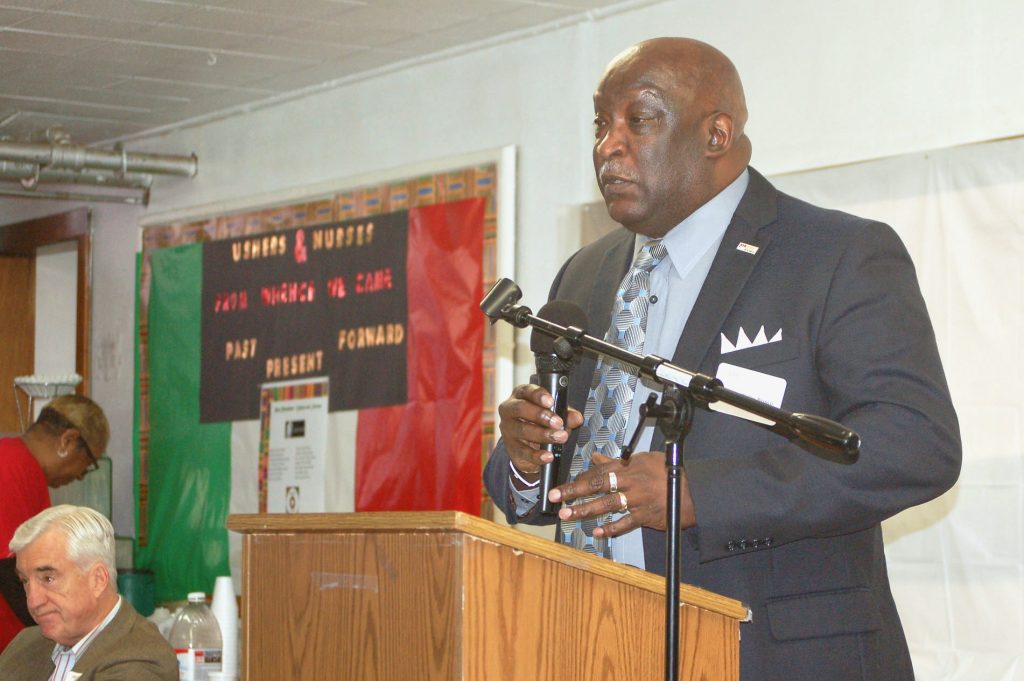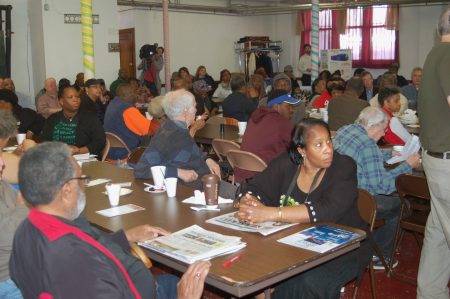Workers Urged to Use JobLines Buses
Freeway lawsuit got $13.5 million settlement; two bus lines to suburban jobs created.

Rev. Willie Brisco, president emeritus of MICAH, addresses the crowd gathered at St. Matthews C.M.E. Church, 2944 N. 9th St., to discuss JobLines. Photo by Edgar Mendez.
Speaking to a packed house gathered for a Community Brainstorming Conference, the Rev. Willie Brisco, president emeritus of Milwaukee Inner-City Congregations Allied for Hope (MICAH), bluntly told the crowd — anxious for new development in the central city — that there would be no skyscraper or factory built next door.
Brisco, who previously called on the Milwaukee Bucks to build its new stadium on West Capitol Drive, said as far as economic benefits trickling down to Milwaukee’s less affluent neighborhoods via the building boom downtown, “We’re still waiting for some of that money to blow off the tops of those skyscrapers downtown into the inner city.”
Long gone and perhaps never to come back again are the days when Milwaukee was the best place in the U.S. for African-Americans, due to the access of family-sustaining jobs close enough to walk or bike to, said District 2 Alderman Cavalier “Chevy” Johnson. The city’s decline, he and Brisco noted, resulted from the loss of industry, and freeway expansions that failed to take into account the prosperity of all communities.
The best short-term option for upward mobility and to lower stubbornly high unemployment rates in African-American communities, Johnson said, is for residents to patronize JobLines. A joint initiative among Milwaukee County Transit System (MCTS), MICAH and the Black Health Coalition of Wisconsin (BHCW), JobLines provides public bus access to jobs in Waukesha and Washington counties.

Residents packed St. Matthews C.M.E. Church for the latest Community Brainstorming Conference. Photo by Edgar Mendez.
Funding for JobLines came about as a result of a $13.5 million settlement of a lawsuit filed by BHCW and MICAH against the State of Wisconsin alleging that the expansion of the Zoo Interchange discriminated against urban minorities. The lawsuit sought to increase employment opportunities for central city residents through creating and expanding bus lines, according to a 2014 statement issued by BHCW.
However, the lawsuit only provided funding through December 2018, said Brendan Conway, chief marketing and communications officer for MCTS. “We don’t know what happens when funding runs out. That’s a good question for Waukesha County and the state,” he added.
JobLines features two routes, Routes 6 and Route 61, that served an average of nearly 800 weekday riders last month, down from 963 in November. Bus ridership fluctuates seasonally depending on hiring patterns, according to Conway.
Funding from the settlement was recently utilized to add trips to Route 6, which has stops along West Capitol Drive, Mayfair and Brookfield Square malls and provides transportation to New Berlin Industrial Park. The additional trips allow employees more opportunities to work overtime and gives employers more flexibility in scheduling, Conway said.
Route 61 has stops on Fond Du Lac, Keefe and Appleton avenues, in addition to Silver Spring, along the way to Menomonee Falls, where riders can connect to Waukesha County and Washington County bus lines and more jobs.
“We need people to work in these very large industrial parks,” said Paul Decker, chair of the Waukesha County Board of Supervisors. Workers are needed from Milwaukee because Waukesha County boasts an unemployment rate of only 3 percent, explained Decker.
“Good luck finding locals to work in your store,” said Decker, recounting a recent exchange he had with a new business owner setting up shop along Bluemound Road in Waukesha County.
A great variety of jobs are available and accessible from Milwaukee via public transit, Decker added, including manufacturing and service jobs for both skilled and unskilled workers. According to its webpage, JobLines routes provide access to more than 150 employers looking to fill about 200 positions.
Having access to work altered the path of Hyman Bradshaw, who lives on the city’s North Side, and is among those who use JobLines. Bradshaw, who said he’d been in and out of the penal system for years, worked a temp job before finding a permanent position in Germantown.
“Getting steady work helped me turn around my life,” Bradshaw said.
Bradshaw’s success story hasn’t been replicated enough in Milwaukee, according to Johnson, who questioned why the combination of a need for jobs and availability of suburban jobs via bus lines, hasn’t better connected the region.
Rodney Daniels, who also attended the conference, said one problem is that young people from Milwaukee, who already feel disenfranchised, have a hard time adapting to the idea that you have to leave your community and work in the suburbs to make a living.
“How do you market that idea to a 17-year-old about to be 18? How can that be sustainable?” Daniels asked.
Brisco added that, in some communities, when you ask a child the last time they’ve gone to Waukesha, they say they’ve never been there. Brisco called for more affordable and attractive housing options for Milwaukeeans who are employed in surrounding counties.
“What they’re telling us by not doing so is, ‘We want your labor but we don’t want you around our homes or around our children,” Brisco said.
Still, it’s up to Milwaukee residents to “expand the paradigm of local children beyond 10 blocks,” he added.
“We want this county [Milwaukee] to prosper, but many of us need those jobs in those [suburban] areas. Some of us need that training over there and some of us just need to get out of the city and see what it’s like,” Brisco said.
This story was originally published by Milwaukee Neighborhood News Service, where you can find other stories reporting on fifteen city neighborhoods in Milwaukee.
Transportation
-
Congestion Pricing Cuts Air Pollution in New York City
 Dec 14th, 2025 by Jeff Wood
Dec 14th, 2025 by Jeff Wood
-
FTA Tells Milwaukee to Crack Down on Fare Evasion — Even Where Fares Don’t Exist
 Dec 12th, 2025 by Graham Kilmer
Dec 12th, 2025 by Graham Kilmer
-
Will GOGO’s Bus Service Ever Get Going?
 Dec 9th, 2025 by Jeramey Jannene
Dec 9th, 2025 by Jeramey Jannene





















